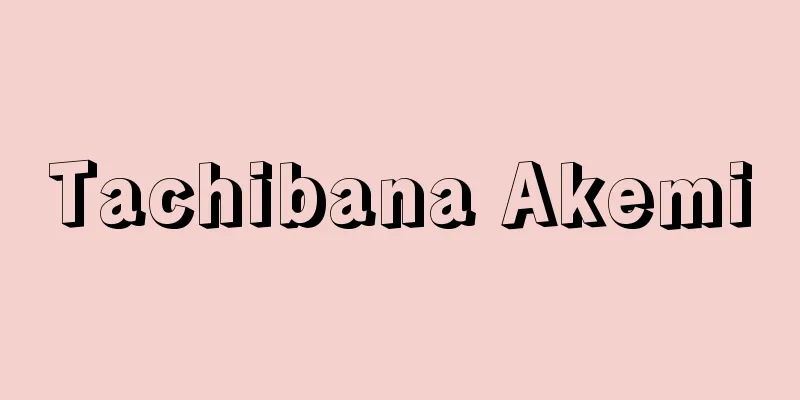Floor - yuka (English spelling) floor

|
This refers to the area that divides the lower part of an architectural space, and since humans carry out various daily activities on this surface, the floor must be constructed to safely support not only its own weight, but also the weight of people and equipment standing on it (the load). The simplest floor is one in which the ground surface is used as the floor surface, or the floor is set up in close contact with this. The floors of ancient pit dwellings are an example of the former, while floors made of pounded clay are an example of the latter, and these are collectively called doma floors. Today, when building a doma floor, the ground is hardened using techniques such as wariguri ground work, waterproofing is applied as necessary, concrete is poured on top, and various finishing touches are applied. However, the most common form of floor is one in which horizontal members such as girders, beams, and joists are separated from the ground to form a floor structure, and floorboards are laid horizontally on top of this. The floor structure is made of wood or steel, or a combination of both, and the floor panels can be made of wood or various molded panels (precast concrete panels, lightweight concrete panels, etc.), steel plates, or steel plates cut into grooves with concrete filled in. Floors made of reinforced concrete are specifically called floor panels (slabs). When building a floor structure that includes a slab, the floor not only provides a place for living space and supports the load, but is also an important structural member that connects the body (the main body of the building) horizontally. [Yamada Koichi] Floor constructionThe floor structure is slightly different between the first floor and the second floor and above. For the first floor, the floorboards are laid on joists that are laid horizontally at regular intervals (less than 45 cm for wooden structures), but when the span of the joists (the distance between the supports) becomes large, the floorboards are supported by obiki (a beam) that crosses at right angles to the obiki, and then by beams that are erected on boulders (natural stones the size of a human head. Nowadays, bricks or concrete blocks are often used) placed on the ground. The Building Standards Act stipulates that the height to the finished surface of the first floor must be more than 45 cm, and that the space under the floor must not be sealed and must be well ventilated, but this is originally to avoid moisture, and is a natural measure in weather conditions like Japan. For floors other than the first floor, the relationship between the floorboards and the joists is the same as for the first floor, but the material that corresponds to the obiki is called a beam. However, in this case, the beams cannot be supported by beams, so a large beam or girder is placed perpendicularly below them to support them. When using a large beam, the original beam is called a small beam. When joists are fixed onto a concrete slab and floorboards are laid on top of that, it is called a rolled joist. Rolled joist floors are also used when setting up temporary floors in sheds, etc. In this case, the material that will serve as the joists is laid on the ground surface and the floorboards are simply nailed to it. [Yamada Koichi] FloorboardsThe surface of a floor slab may be left as the finished surface, or a separate finishing material such as tatami mats, carpets, or parquet may be laid on top of it. It goes without saying that floors in general should be less prone to wear, easier to clean, and more attractive, but there are also strong requirements for different properties depending on how the floor is used. For example, in Western-style buildings, people often wear their shoes on the floor, so wear resistance is especially important, and washable floors may be required, but in Japanese-style homes, people usually take their shoes off, so floors that are somewhat elastic and feel good to the touch are more important than wear resistance. Suitable flooring materials for the former include concrete or cement mortar, tiles or mosaic tiles, stone veneer or artificial stone (terrazzo), while tatami mats are ideal for the latter. Flooring materials such as planks, carpets, rubber tiles, linoleum, and synthetic resin tiles are intermediate between these two. Special floors include vibration-absorbing floors in gymnasiums to prevent vibrations from being transmitted to the structure, and conductive floors in hospital operating rooms to prevent static electricity from building up. Also, a long-standing technique has been to install hot water pipes in the floor structure or concrete slab in advance to heat the entire floor surface. [Yamada Koichi] historyIn many parts of the world, floors began as earthen floors on the ground or dug into the ground, sometimes with stones laid on top or lime plaster applied, but as living standards improved and building techniques advanced, floors gradually came to be built above ground level. In particular, in humid regions such as Japan, structures with floors raised above the ground and built with flooring were used from early on. Buildings with such raised floors can already be seen in bronze bells (1st to 2nd century) said to have been excavated in Kagawa Prefecture and house drawings cast into a house mirror (late 4th century) excavated from the Samida Takarazuka Tomb in Nara Prefecture. At the Toro ruins, it is known that while general dwellings were pit-type buildings, raised-floor wooden storehouses were also used for granaries, and the same can be said for the main hall of Ise Shrine, although it has been rebuilt many times. Such raised floors later became a traditional style of Japanese architecture, eventually completing the style seen in the Katsura Imperial Palace. In places where the earthen floor was abandoned early on, people still lived with their shoes off and seated, but in low-humidity or cold regions, even if the floor was raised off the ground, the earthen floor style was still followed, and people lived with their shoes on and chairs. This style is still in use today not only in the West but also in the Asian continent, especially north of the Yellow River basin. The earthen floor and chair-style architectural style, built on a high platform, was introduced to Japan from China, but while this was adopted for temples and palaces (places where official events are held, such as the Daigokuden), it did not change the style of housing that was directly related to daily life. Even in temples, floors were later built, and in the imperial court, buildings such as the Shishinden, which were the private living space for the emperor and below, remained raised floors. Chair-style living in Japan began of course after the Meiji period, and even then it was limited to public life, and it was only after World War II that it began to spread to homes. In the days when pit dwellings still had strong traces, it is believed that grass and straw were used as flooring materials on the dirt floor, and in the Daijokyu ceremony described in the Jogan Ceremony (completed in 872), grass, bamboo mats, and matting were layered, but after that, the flooring was entirely made of wooden boards. Tatami first appeared in picture scrolls from the Kamakura period as tatami mats placed partially on a wooden floor as seats for nobles, and from around the end of the Muromachi period, they began to be laid out to cover the entire room, as they are today. There are also examples of tiles being used on the dirt floors of temples, but the use of other floor finishing materials such as carpet and linoleum has of course only come about after the introduction of Western civilization, and synthetic resin tiles were invented after World War II. [Yamada Koichi] [Reference item] |©Shogakukan "> Floor finishing structure example (1) ©Shogakukan "> Floor finishing structure example (2) Source: Shogakukan Encyclopedia Nipponica About Encyclopedia Nipponica Information | Legend |
|
建築空間の下方を区画する部位をいい、人間はこの上面でもろもろの生活活動を営むことになるので、床は自重のみならず、その上にのる人や器具の重量(積載荷重)を安全に支える構造でなければならない。床のもっとも簡単なものは地盤面をそのまま床面とし、またはこれに密着して床を設定する場合である。古代の竪穴(たてあな)住居の床は前者、三和土(たたき)でたたき固めた床は後者の例で、これらは土間床と総称される。現在、土間床をつくる場合は割栗(わりぐり)地業などによって地盤を固め、必要に応じて防水処理を施し、その上にコンクリートを打設し各種の仕上げをする。しかし、床のもっとも一般的な形は、地盤から離して桁(けた)、梁(はり)、根太(ねだ)などの横架材を縦横に組み合わせて床組みをつくり、その上に水平に床板を張るものである。床組みは木骨または鉄骨もしくはその併用により、床板は木材のほか各種成型板(プレキャストコンクリート版、軽量コンクリート版など)、鉄板またはそれを溝形に加工し、そこへコンクリートを埋めるようにしたものも用いられる。なお床を鉄筋コンクリートとしたものをとくに床版(ゆかばん)(スラブslab)とよんでいる。スラブをも含めて床組みを組む場合、床は単に生活空間の場を提供して荷重を支えるだけでなく、躯体(くたい)(建物の本体)を水平に緊結する重要な構造部材でもある。 [山田幸一] 床組み床組みは1階床と2階以上の床とでは多少構造が異なる。1階床の場合、床板は一定間隔(木造の場合は45センチメートル以下)に横架された根太の上に張るが、根太のスパン(支点間の距離)が大きくなるときは、その下をこれと直交する大曳(おおびき)(大引)で受け、地盤上に置いた玉石(たまいし)(人頭大の自然石。現在ではれんが、コンクリートブロックなどを用いることが多い)の上に立てた束でさらにこれを受ける。一階床の仕上げ面までの高さは45センチメートル以上とし、かつ床下は密閉せず通風をよくすることを建築基準法で規定しているが、もとよりこれは湿気を嫌うためで、日本のような気象条件の下では当然の処置である。1階以外の床組みでも床板と根太との関係は1階床と変わらないが、大曳にあたる材は梁とよぶ。しかし、この場合は梁を束で支えられないので、さらにその下に大梁または桁を直交させてこれを受ける。大梁などを用いるときは元の梁をとくに小梁という。コンクリートスラブの上に根太を固定し、その上に床板を張るものは転(ころ)ばし根太とよぶ。転ばし根太の床は仮小屋などで一時的な床を設けるときにも応用され、この場合は地表に根太にあたる材料を横たえ、それに床板を打ち付けるだけである。 [山田幸一] 床板床版は、その表面をそのまま仕上げ面とする場合と、その上に畳、じゅうたんなどを敷き、あるいは寄木(よせぎ)やフローリングブロックを張るなど仕上げ材を別に用いる場合とがある。床一般の性格から摩耗が少なく清掃が容易でかつ美麗なもののよいことはいうまでもないが、その床の使用法によっておのずから強く要求される性質がある。たとえば洋風建築では土足のままの使用が多いので耐摩耗性がとくに必要で、水洗可能なものが求められることもあるが、和風住宅では脱靴するのが普通であるから、耐摩耗性よりもむしろある程度弾力性に富み肌ざわりのよいものが要請される。前者に適合したものとしてコンクリートまたはセメントモルタル、タイルまたはモザイクタイル、石張りまたは人造石とぎ出し(テラゾー)などがあり、後者に最適のものとして畳がある。板張り、カーペット、ゴムタイル、リノリウム、合成樹脂タイルなどはその中間的な存在である。 特殊な床として、体育館などでは振動を躯体に伝えないための振動吸収床、病院の手術室などでは静電気の滞留を防ぐための電導床などが要求される。また床組みまたはコンクリートスラブの中にあらかじめ温水用配管などを組み込んでおき、床面全体を暖房するくふうも古くから行われている。 [山田幸一] 歴史世界各地とも床は地表またはそれを掘った土間床に始まるのが普通で、ときにその表面に石を敷いたり石灰プラスターを塗ったりしているが、生活水準の向上と建築技法の進歩により床は漸次地表より上に設けられるようになる。とくに日本のように多湿の地域では床を地盤より離し床組みを組む構造が早くから行われている。香川県出土と伝えられる銅鐸(どうたく)(1~2世紀)や奈良県の佐味田(さみだ)宝塚古墳出土家屋文鏡(4世紀後半)に鋳出された家屋図には、すでにそのような高床をもつ建物がみられ、登呂(とろ)遺跡では一般住居は竪穴式であっても穀倉にはやはり高床式板校倉(あぜくら)の用いられていたことが知られており、造り替えが繰り返されているとはいえ、伊勢(いせ)神宮正殿も同様である。このような高床はその後の日本建築の一つの伝統様式となり、ついには桂(かつら)離宮殿舎のような造型を完成した。このように土間床と早く決別したところでは脱靴・座式の生活が行われるが、低湿または寒冷の地域では床を地盤から上に離しても土間床の形式が踏襲され、ここでは土足・椅子(いす)式の生活が行われる。西洋のみならずアジア大陸、とくに黄河流域以北では現在でもおおむねこの形式である。日本へも中国から基壇を高く築いた土間床、椅子式の建築様式が伝えられたが、これは寺院や宮殿(大極殿(だいごくでん)など公式行事を行うところ)には採用されても、生活に直結する住宅形式までは変えられず、寺院においてすらのちには床がつくられ、宮廷でも天皇以下の私的な生活空間である内裏(だいり)の建物(紫宸殿(ししんでん)など)は高床に終始してきた。日本で椅子式の生活が行われるのはもとより明治以降で、それも公的生活面に限られ、住宅にまで浸透し始めるのはようやく第二次世界大戦以降のことである。床材料は竪穴住居の名残(なごり)の強い時代では土間に草、藁(わら)などを敷いたものと思われ、『貞観(じょうがん)儀式』(872成立)にみる大嘗宮(だいじょうきゅう)では束草(つかくさ)、竹簀子(たけすのこ)、蓆(むしろ)を重ねることになっているが、その後はすべて板敷きとなった。畳は鎌倉時代の絵巻物にまず高貴の人の座として板床の上に部分的に置かれる置き畳として現れ、室町末期ごろから部屋内いっぱいに敷き詰められることになり現在に至っている。そのほか寺院の土間床に敷き瓦(がわら)(タイル)などの用いられた例はあるが、他の床仕上げ材、たとえばカーペット、リノリウムなどの用いられるのはもとより西欧文明導入以降のことであり、合成樹脂タイルは第二次大戦後の発明である。 [山田幸一] [参照項目] |©Shogakukan"> 床の仕上げ構造例(1) ©Shogakukan"> 床の仕上げ構造例(2) 出典 小学館 日本大百科全書(ニッポニカ)日本大百科全書(ニッポニカ)について 情報 | 凡例 |
<<: Togo - Togo (English spelling)
>>: Thorn forest - Togerin (English spelling)
Recommend
Sotaro Iba
1851-1903 A swordsman and educator from the Meiji...
Grand Master of Seasons - Grand Master of Seasons
Year of death: August 7, 1487 (August 25, 1487) Ye...
strawberry-raspberry (English spelling) strawberryraspberry
... R . phoenicolasius Maxim. (English name: wine...
Shaanxi Province - Teacher
A province in central China. Its capital is Xi'...
Wire puller
...In Kabuki, the word kuromaku means a blackout,...
Small insect - Small insect
They live on the undersides of rocks in the intert...
Favrile glass
…He dissolved the joint company in 1882 and found...
Finsider
...After the war, the West German steel industry ...
Kusaboke - Kusaboke
A deciduous small shrub of the Rosaceae family (A...
Ikura - How much
This is a district in Tamana City, Kumamoto Prefe...
MERZ
…After the end of World War I, he moved from Dada...
Coliidae
…General term for birds of the family Coliidae, o...
Poison - poison
A word that refers to poisonous natural substance...
Onji (soil) - Onji
…The name comes from the fact that the topsoil is...
Long-tongued fruit bat (English spelling)
A general term for mammals belonging to the subfam...









